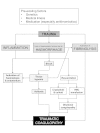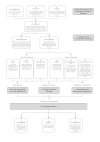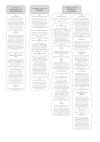Management of bleeding and coagulopathy following major trauma: an updated European guideline
- PMID: 23601765
- PMCID: PMC4056078
- DOI: 10.1186/cc12685
Management of bleeding and coagulopathy following major trauma: an updated European guideline
Abstract
Introduction: Evidence-based recommendations are needed to guide the acute management of the bleeding trauma patient. When these recommendations are implemented patient outcomes may be improved.
Methods: The multidisciplinary Task Force for Advanced Bleeding Care in Trauma was formed in 2005 with the aim of developing a guideline for the management of bleeding following severe injury. This document represents an updated version of the guideline published by the group in 2007 and updated in 2010. Recommendations were formulated using a nominal group process, the Grading of Recommendations Assessment, Development and Evaluation (GRADE) hierarchy of evidence and based on a systematic review of published literature.
Results: Key changes encompassed in this version of the guideline include new recommendations on the appropriate use of vasopressors and inotropic agents, and reflect an awareness of the growing number of patients in the population at large treated with antiplatelet agents and/or oral anticoagulants. The current guideline also includes recommendations and a discussion of thromboprophylactic strategies for all patients following traumatic injury. The most significant addition is a new section that discusses the need for every institution to develop, implement and adhere to an evidence-based clinical protocol to manage traumatically injured patients. The remaining recommendations have been re-evaluated and graded based on literature published since the last edition of the guideline. Consideration was also given to changes in clinical practice that have taken place during this time period as a result of both new evidence and changes in the general availability of relevant agents and technologies.
Conclusions: A comprehensive, multidisciplinary approach to trauma care and mechanisms with which to ensure that established protocols are consistently implemented will ensure a uniform and high standard of care across Europe and beyond.
Figures



Comment in
-
Management of bleeding following major trauma: is a target haemoglobin of 7 to 9 g/dl high enough?Crit Care. 2013 Jul 31;17(4):442. doi: 10.1186/cc12767. Crit Care. 2013. PMID: 23905923 Free PMC article. No abstract available.
References
-
- World Health Organisation. World Health Statistics 2009: Cause-specific mortality and morbidity. http://www.who.int/whosis/whostat/EN_WHS09_Table2.pdf
-
- Frith D, Goslings JC, Gaarder C, Maegele M, Cohen MJ, Allard S, Johansson PI, Stanworth S, Thiemermann C, Brohi K. Definition and drivers of acute traumatic coagulopathy: clinical and experimental investigations. J Thromb Haemost. 2010;17:1919–1925. doi: 10.1111/j.1538-7836.2010.03945.x. - DOI - PubMed
Publication types
MeSH terms
LinkOut - more resources
Full Text Sources
Other Literature Sources
Medical

